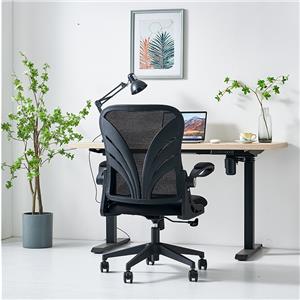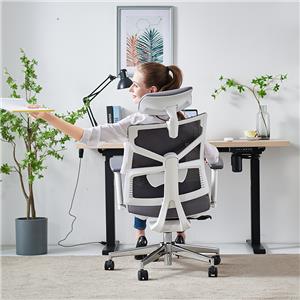8 hours of mad spine! Office workers "7 mines" posture
It is very common for office workers to suffer from shoulder and neck pain, back pain, low back pain, and even knee pain. You may have gone to many places for health insurance, medical treatment at your own expense, and done a lot of exercise to improve your posture, but you often still feel that "no Totally fine." Why is this?
Chances are that your office environment has been forcing you to be in poor physical condition. To use an analogy, you originally had a healthy blood bar full of 100 points, but because of the poor posture of the work environment, desks and chairs, etc., 10 drops of blood will be deducted every round. After a few rounds you're down to 30 drops and you're in so much pain that you're going to a doctor, a physiotherapist for all sorts of treatments. These healers will help you recover 30 to 60 drops of blood, and you will soon be a living dragon again!
But when you go back to work, it starts to hurt again, because you are deducted 10 drops of blood every round, because your desk and chair put your body in a relatively poor position for work. It's okay for a short time, but after a long time, it's easy to have muscle soreness, numbness in hands and feet, and hunchback. When your posture and joint mobility are changed, it may change the way your body walks and moves, causing discomfort in many parts of your body.
Seven principles for adjusting the office environment
In addition to improving your physical condition and exercising more, now I want to tell you how to adjust the office environment from the principles of biomechanics.
1. Bottom-up: adjust the chair first, then adjust the computer. Get your sitting posture first, and then let the computer match your sitting posture.
2. The first and most important thing is to change to a chair that will not slide around.
You read that right, most office chairs with pulleys are convenient and convenient, but they are not good for your waist and legs. Because your body is trying to stabilize the chair so that you can continue to work, the waist and calves will unconsciously expend extra effort to stabilize. If you sit in an office for 8 hours a day, your waist and calves will subconsciously support you for 8 hours!
I would suggest getting a chair that doesn't slide around, or something to hold the chair's pulleys in place. If your work needs to move the chair, but it is not so slippery, half and half, I would suggest cutting the tennis ball, or cutting the bottom half of the plastic bottle to fit the chair wheel.
3. Adjust the height of the chair and do not let your feet hang and open.
The height of the chair is very important. If the chair is too short, the pressure on the lumbar spine and pelvis will immediately increase, and the knee joint will also be over-bent, which will cause excessive pressure on the patellofemoral joint, and the table will be relatively high. When you are working It is necessary to support the shoulders in a relatively high position, which is prone to soreness.
What if the chair is too high? At this time, the feet need to be on the toes to touch the floor, or the knee joints will be bent too much so that the feet can rest on the casters, which may cause excessive tension in the calves and excessive forward tilt of the pelvis; Those who are shorter may have a hunchback problem when working at such an angle.
The most suitable height is the height at which you can easily and naturally work on the table with your hands after you sit up straight and lean your back to the back of the chair. At this time, you may ask, what if I am very short or very tall?
Shorter people may have problems with their feet hanging in the air. I would suggest putting a bench, clever mats, etc. to accommodate your feet. If you are too tall, then I would suggest to do the opposite, adjust the chair to the height of your feet just on the floor, the table will be relatively low, then you have two options: change the table, or under the computer Place things to make the computer taller.
As a reminder, according to biomechanics, the knees will be excessively extended or the bad posture of crossing the legs may cause problems such as too tight iliotibial band and valgus of the patella, resulting in knee joint pain. If it is convenient, you can wrap the thighs with a towel and press the two ends of the towel under the thighs, which can effectively fix the thighs and prevent them from opening too much.
4. Sit well and then lean back.
Sit the chair full first, and then let the whole spine lean on the back of the chair. Try not to let the back of the waist hang in the air, otherwise it is easy to have soreness. If necessary, a lumbar support can be added to the back of the chair to support the lower back.
5. Use an external keyboard and mouse.
In the era of desktop computers, we could adjust the positions of the screen, keyboard, and mouse separately. But now that everyone has a laptop, it is obviously difficult to achieve the position of the screen mentioned in the previous point, and to allow the hands to be placed easily and naturally. At this time, it is recommended that you use a laptop stand to elevate the laptop, and then connect an external keyboard and mouse to keep your hands in a comfortable position. It will cost some money, but it will save you future pain and medical bills.
6. Adjust the position of the screen.
The position of the screen should allow you to straighten your eyes and look directly at it, so as not to make you hunchback, turtle neck, affect the cervical spine, thoracic spine, shoulders, and even lumbar spine. Adjust the screen to get the height first, so that you can sit up straight and look down a little. Then adjust the distance, don't let your body lean forward to read the words, get closer.
7. Don't neglect your elbows.
The weight of an adult's arm is at least 4-5 kg. If you use the computer at the desk for a long time, the muscles of the shoulders and muscles must pull the weight of the arm for a long time, which is prone to shoulder and neck pain and is not good for the cervical spine. chance of inflammation. Elbows have to be placed, another advantage is that it can reduce the pressure on the lumbar spine.
You can rest your hand on the arm of a table, chair, or throw pillow. If the armrest of the chair can be adjusted, it is recommended to adjust the height to the height where the elbow can hang naturally, and the elbow is placed within 15 cm from the sides of the body.




